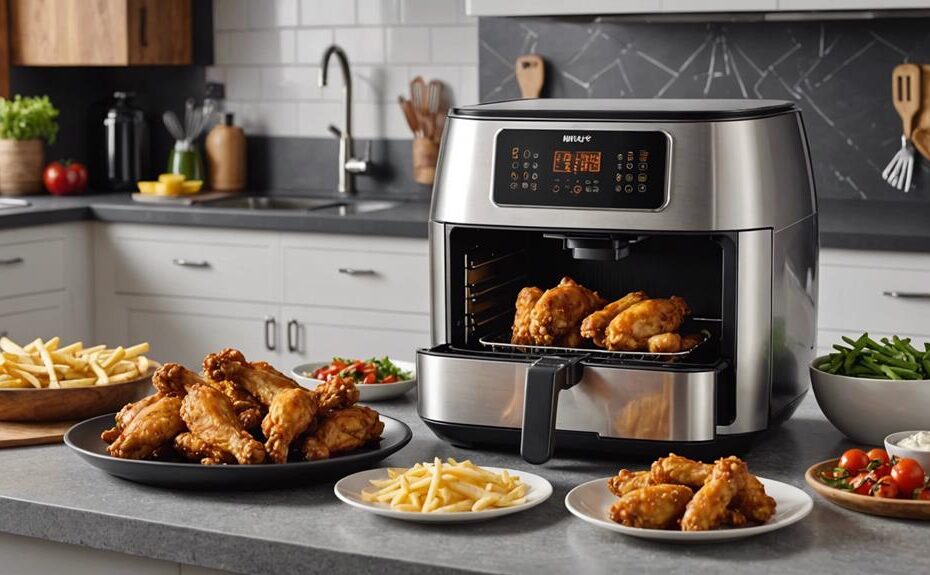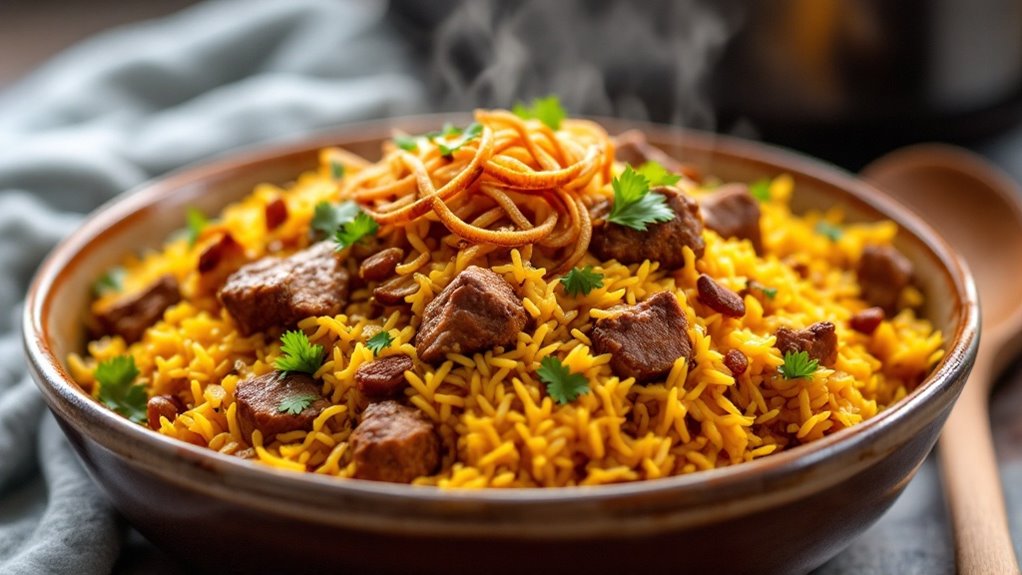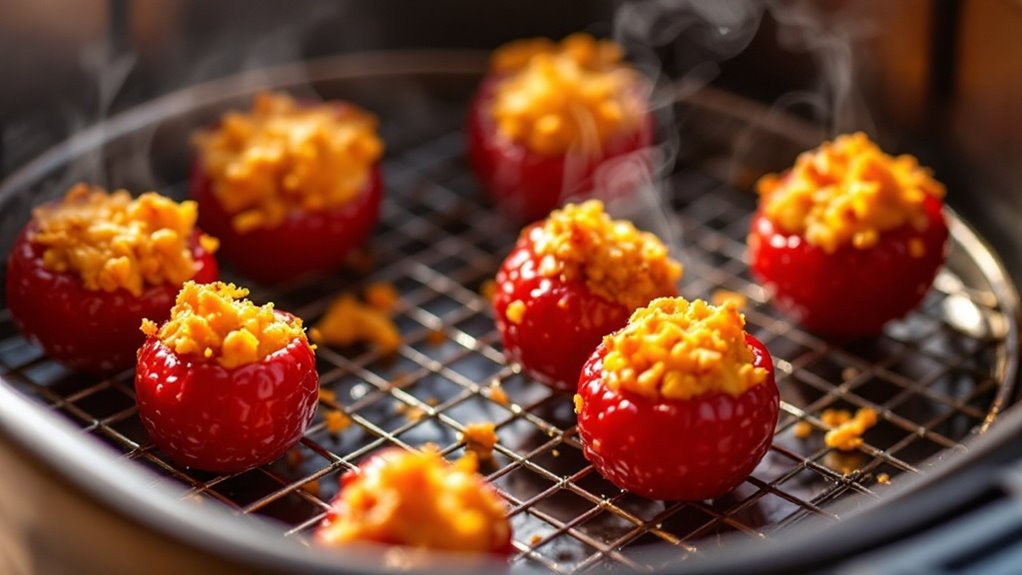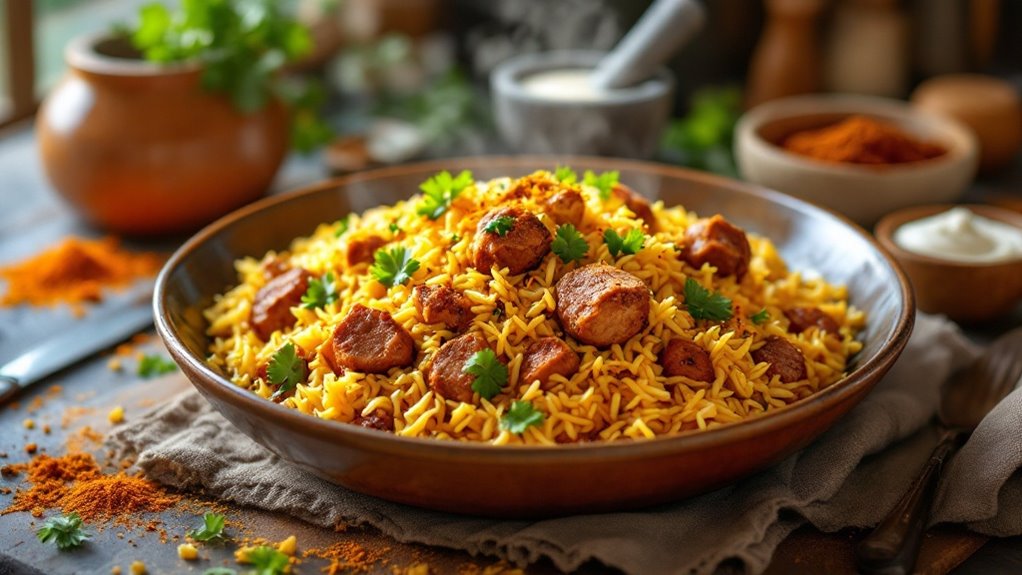When comparing an air fryer to a convection oven, you'll notice a few key differences. Both use hot air circulation, but air fryers are more compact, requiring less preheating time, and are excellent for small, quick meals. Convection ovens, on the other hand, handle larger quantities with a broader temperature range and more cooking modes, making them ideal for complex recipes. Air fryers are easier to clean and more energy-efficient for limited portions. Convection ovens offer extensive versatility and larger cooking capacity. Studying further will provide a deeper understanding of their best uses.
Key Takeaways
- Air fryers preheat and cook faster due to their compact design.
- Convection ovens offer larger cooking capacities and more versatility for complex recipes.
- Air fryers are more energy-efficient for small meals and quick tasks.
- Convection ovens provide broader temperature ranges and extensive cooking settings.
- Air fryers are easier to clean and feature convenient preset functions.
How Convection Ovens Work
Convection ovens consistently utilize a fan to circulate hot air, promoting faster and more even cooking. By integrating the fan, convection ovens promote even heat distribution, which is essential for achieving uniform results in baking, roasting, and toasting. The fan works by constantly moving hot air around the food, minimizing hot and cold spots within the oven cavity. This dynamic airflow speeds up the cooking process and enhances browning, resulting in dishes that are cooked more quickly and evenly compared to conventional ovens.
When using a convection oven, preheating is important. Preheating ensures that the oven reaches the desired temperature before you place your food inside, optimizing the even heat distribution from the start. This step is particularly important for baking, where precise temperature control is crucial for achieving perfect results. For roasting, the consistent circulation of hot air ensures that meats are cooked thoroughly while maintaining moisture and achieving a crispy exterior. Toasting benefits from the rapid and even heat, providing a golden-brown finish without burning.
Convection ovens also offer versatility by accommodating larger food items and multiple dishes simultaneously. This makes them an excellent choice for diverse cooking needs, delivering efficiency and consistent quality.
How Air Fryers Work
Leveraging rapid air technology, air fryers circulate hot air around the food to achieve crispy and evenly cooked results with minimal or no oil. This process is facilitated by a powerful fan located at the top of the appliance, which guarantees the hot air is distributed effectively. The smaller cooking area in air fryers compared to a convection oven allows for quicker and more efficient heating, reducing cooking times considerably.
Air fryers use this concentrated hot air to mimic the effects of frying, but without the excessive use of oil, making them a healthier option. The fan to circulate the air ensures that the heat reaches every part of the food uniformly, eliminating cold spots and ensuring consistent cooking. This method also reduces the likelihood of overcooking or undercooking.
Compared to a convection oven, the compact design of an air fryer allows for quicker preheating, translating to faster meal preparation. Air fryers are particularly effective for smaller batches of food, making them ideal for single servings or small family meals. Overall, air fryers offer a blend of efficiency and health benefits, providing a convenient alternative for everyday cooking needs.
Preheating Time

Air fryers generally preheat much faster than convection ovens, thanks to their compact design and smaller chamber. This quicker preheating stems from the reduced chamber size, allowing air fryers to reach the desired temperature more swiftly. Typically, you'll find that air fryers need only a few minutes to preheat, whereas convection ovens often require noticeably longer preheating times.
The smaller size of air fryers plays an important role in this efficiency. With less space to heat, air fryers can ramp up to cooking temperature rapidly, which is especially beneficial when you're preparing smaller portions. This efficiency can save time and make the cooking process more convenient.
However, it's important to note that preheating times can vary between different models of air fryers and convection ovens. While air fryers consistently offer quicker preheating, individual model specifications may influence exact times. Convection ovens, due to their larger chamber size, inherently take longer to preheat, which might be a drawback if you're in a hurry.
Cooking Capacity
When evaluating cooking capacity, you'll find that convection ovens offer much more space, making them suitable for preparing larger meals. Convection ovens have larger cooking capacities, allowing you to cook substantial amounts of food simultaneously. They can accommodate larger dishes such as roasts and multiple trays of cookies, making them ideal for families or gatherings where meal sizes are more significant.
On the other hand, air fryers are designed for smaller portions. Their cooking basket limits the amount of food you can prepare at once, typically serving one to two people. This makes air fryers less suitable for large families but perfect for individuals or small households who don't need to cook extensive meals.
When choosing between an air fryer and a convection oven, consider your typical meal sizes and cooking needs. If you often cook for a crowd, a convection oven's larger cooking capacity will meet your requirements better. However, if you focus on smaller portions and quicker individual meal servings, an air fryer might be more convenient. Understanding these differences in cooking capacity will help you make a more informed decision based on your specific food amount and meal servings.
Temperature Range
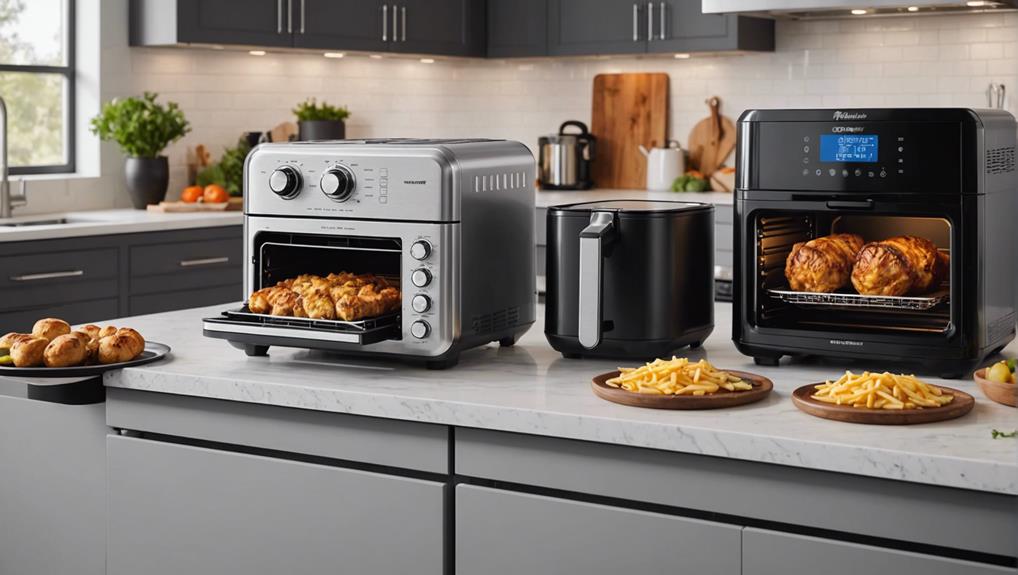
Exploring the temperature range of air fryers and convection ovens reveals key differences that can greatly impact your cooking results. Convection ovens typically offer a broader temperature range compared to air fryers, which allows for more precise control over your cooking temperatures. This expanded range is essential for achieving ideal results across a wider variety of recipes. For instance, Whirlpool convection ovens may feature Convection Conversion technology, automatically adjusting temperatures to suit convection cooking, thereby enhancing your cooking outcomes.
Air fryers and convection ovens both generally operate at temperatures 20-25 degrees lower than traditional ovens. This similarity ensures that you can achieve comparable cooking outcomes whether using an air fryer or convection oven. However, the precise control offered by convection ovens often makes them a more versatile option for complex recipes.
Understanding these temperature ranges is crucial for efficient cooking. While air fryers are excellent for specific tasks, the broader temperature capabilities of convection ovens provide more flexibility. This flexibility allows you to fine-tune the cooking process, ensuring that your dishes are cooked to perfection. Ultimately, knowing how each appliance handles temperature can lead to more consistent and satisfactory cooking results.
Versatility and Controls
Delving into the versatility and controls of convection ovens and air fryers reveals that convection ovens offer a more extensive range of cooking settings, providing greater flexibility and precision for diverse culinary tasks. Convection ovens come equipped with advanced controls that facilitate precise temperature adjustments, enabling you to customize your cooking process. With settings for baking, roasting, and broiling, convection ovens are adept at handling a wide variety of cooking techniques, thereby enhancing their versatility.
In contrast, air fryers often feature simpler controls with preset functions designed primarily for air frying and crisping. These preset functions simplify the cooking process, making air fryers user-friendly but somewhat limited in versatility. While you can achieve a crispy texture with ease, the range of culinary tasks you can perform remains narrower compared to convection ovens.
The customization capabilities of convection ovens allow for detailed control over temperature and cooking settings, making them suitable for complex recipes that require precision. Air fryers, on the other hand, excel in convenience and ease of use, making them ideal for quick meals but less adaptable when it comes to diverse cooking requirements. Therefore, when considering versatility and controls, convection ovens clearly offer a broader spectrum of culinary possibilities.
Frequently Asked Questions
Which Is Better, an Air Fryer or a Convection Oven?
You should consider cooking versatility and size limitations. Air fryers are energy-efficient, easy to clean, and offer health benefits with quick cooking speed. Convection ovens excel in temperature control, food texture, use frequency, and overall appliance cost.
Can You Get the Same Results With a Convection Oven as With an Air Fryer?
Can you achieve the same results with a convection oven as with an air fryer? You can, but consider cooking speed, crispiness factor, preheat time, energy efficiency, space requirements, versatility options, maintenance ease, noise levels, and nutrient preservation.
What Are the Disadvantages of Air Fryer?
You'll find air fryers have disadvantages like limited cooking capacity, higher noise levels, and cleaning difficulty. They require more maintenance, have space requirements, and may affect food texture. Recipe limitations and odor issues can also arise.
Why Are People Getting Rid of Air Fryers?
Although air fryers boast healthy cooking, they've limited capacity and high noise levels. You might find their single purpose, cleaning difficulty, and counter space consumption frustrating. Their batch cooking, cooking odor, and high cost deter many users.
Conclusion
You'll find that while both air fryers and convection ovens offer efficient cooking, they cater to different needs. For instance, if you're preparing a quick meal for one, an air fryer's rapid preheating and compact size are ideal. However, for larger family dinners, a convection oven's greater capacity and wider temperature range are more suitable. Ultimately, your choice hinges on your specific cooking habits and volume requirements.
Disclosure: As an Amazon Associate, I earn from qualifying purchases.
